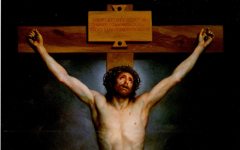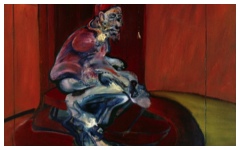Bacon’s Two Men Working in a Field (1971)
Like many great artists Francis Bacon re-used an immense variety of sources from both fine art and popular culture. David Sylvester has shown how Two Men Working in a Field (left) was transformed from a Renaissance work, Raphael's giant cartoon for a Vatican tapestry, The Miraculous Draught of the Fishes.1 Not only was the original itself at the V&A Museum, just round the corner from Bacon's London studio, but he owned an ink-stained copy of a book on Raphael's cartoons, found in his studio after his death and now preserved with all its contents in Dublin.
Click next thumbnail to continue

Raphael, The Miraculous Draught of the Fishes, leaf from a book owned by Bacon, John White, The Raphael Cartoons, 1972. Dublin City Gallery The Hugh Lane RM98NF49
Click image to enlarge.
I have long thought without any convincing evidence that the two symmetrical figures of the fishermen-disciples represented Raphael's divided soul as they "draw" his art out of the water whose surface, metaphorically, is that of his own mind or inner eye. Once they have achieved spiritual purity by "feeding on" the knowledge provided by Christ or the inner eye, the divided soul will be united.
Click next thumbnail to continue

Top: Bacon, Two Men Working in a Field (1971) Oil on canvas
Bottom: Millet, The Gleaners (1857)
Click image to enlarge.
Bacon may have had the same thought because he turned the two disciples into symmetrical figures pulling and pushing "paint" across the surface of his "eye" with rakes in place of brushes. An oval is an odd shape for a field, natural for an eye. The black edge even hints at the shadow of an eyelid. The two "saintly" figures laboriously "making art" recalls Millet's nineteenth-century agricultural workers who also, metaphorically, move earth around as though it was "paint" on the earth's surface. In the example below, the workers are now poor women picking at the remains of the field, God's "canvas".
Click next thumbnail to continue
Even the metal tines of Bacon's rakes resemble eyelashes, a second smaller set of eyes, perhaps, within the inner eye of wisdom. Bacon himself said that he wanted to show how the figures "were totally absorbed in their work and that patch of earth, but it failed." When asked why the two figures were identical, he responded that he was trying "to make a concentrated image, unsuccessfully."2 Had he been successful, though, on the metaphorical level the two figures, divided in "our own reality", would have become one, united in God, i.e. his own mind. Despite any evidence of religion in Bacon's canvas, the source in Raphael imparts spiritual meaning that Bacon, to my mind, clearly intended.
As in many of Bacon's compositions we are inside his mind behind his eyes. The two distorted figures, like many others, are representations of himself but seen from various angles, like objects in a Cubist painting. Bacon's compositions are, I believe, mental images of the painting itself at the moment of its conception. I have explained elsewhere how Picasso's Cubist pictures (but not necessarily Braque's) are mental images.3 Both Mozart and Beethoven testified that a mental image of a composition was like a three-dimensional work-of-art seen from all sides simultaneously.4 That is, in effect, what we look at in both Picasso and Bacon.
More Works by Bacon
Find out what the studio and Golgotha have in common

Mengs’ Christ on the Cross (1761-9), Goya’s and Francis Bacon’s too
Recommended Resources
Notes:
1. David Sylvester, "Francis Bacon and the Nude", exh. cat. Faggionato Fine Art, Francis Bacon: Studying Form (London) 2005, pp. 27-8
2. Hugh M. Davies, "Interviewing Bacon, 1973" in Francis Bacon: New Studies (Göttingen: Steidl) 2009, p. 112
3. Abrahams, "Cubism Explained" (blog, www.everypainterpaintshimself.com)
4. “Mozart: A Letter” in Brewster Ghiselin, The Creative Process (New York: The New American Library) 1952, p.45; Beethoven: Letters, Journals and Conversations, ed. M. Hamburger (New York: Pantheon Books) 1952, p. 195, cited in Albert Rothenberg, “Homospatial Thinking in Creativity”, Archives of General Psychiatry 33, 1976, p.20
Original Publication Date on EPPH: 11 May 2012. | Updated: 0. © Simon Abrahams. Articles on this site are the copyright of Simon Abrahams. To use copyrighted material in print or other media for purposes beyond 'fair use', you must obtain permission from the copyright owner. Websites may link to this page without permission (please do) but may not reproduce the material on their own site without crediting Simon Abrahams and EPPH.





